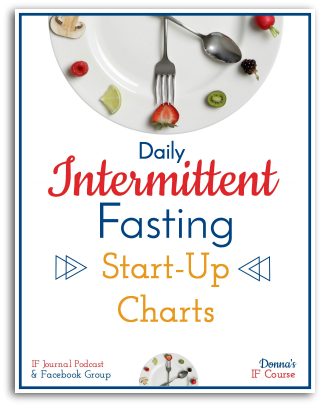Slideshow: 5 Tips for Navigating “Special” Occasions During Daily Intermittent Fasting
by Donna Reish
For optimal viewing on a mobile device, tilt your device to landscape mode.
5 Tips for Navigating "Special" Occasions During Daily Intermittent Fasting
#1
Every Day Can’t Be a Special Day
While raising and homeschooling seven children for thirty-two years, we often had children want to “change” the schedule or change the plans for “special” occasions. “Can we skip math today? It’s snowing…we’re going to the dentist…we’re sleepy…we’re happy…we’re tired…” Take your pick. And I would give them my typical answer: “Every day can’t be a ‘special day’ even though every day is ‘special’!” In other words, we have to choose our special to create exceptions for; we can’t change our schedule all the time.
When we look at our week and try to find “special days,” we are falling back into the diet mentality–that mentality in which we are looking for loopholes and excuses to get out of our prescribed eating protocol. We don’t need to do that with Daily Intermittent Fasting! This lifestyle is so doable that it really can be just that–a lifestyle. We need to quit looking for ways that we can extend our eating window or shorten our fasting window. Quit looking for ways that we can go “off”–and instead make this a way of life, knowing that the end result will be health, wellness, and weight management.
#2
Choose Your “Specials” Carefully
Instead of looking for ways and times to go “off” and “on,” we should be guarding our fasting time and keeping close tabs on our feeding time. They should become automatic and welcomed. When we guard our fasting time, knowing that the longer and more often we fast, the sooner we will be at our goals, we quit looking for “special” and try to make even the truly “specials” doable–figuring out how we can still get in a sixteen or eighteen hour fast on vacation or trying to make a later lunch date with a friend. We will WANT to fast–not want to get out of it.
Thus, we must choose our “specials” carefully. A recurring day is not special. Saturday comes every seven days. When we do have a unique situation, we need to tweak our fasting window the day before a “recurring special” so that we finish eating earlier if we are going to start eating earlier the next day. A holiday might be special. A weekend get away (if we don’t do them monthly!) might be special. A birthday party for a close family member might be special. A vacation is special. But every day can’t be a “special day.”
#3
Make Little Tweaks and Schedule Changes As Needed Rather Than “Going Off IF”
When we do come across a day that needs some “tweaking” in order to have a decent-length fast, we need to plan for that day earlier in the week, rather than just giving up and eating for a long period of time. We know when a brunch is coming up that we can’t get out of. We know when we’ll be having a business lunch that week. So we need to look at that week and see how we can still get fasting hours in–even on those “semi special” days. There are a few ways to do this in order to still keep a fasting average intact. (You can use an app to track your average fasting hours for the last seven days to be sure that even a shorter fasting window of 17 or 18 hours {or whatever} doesn’t take your fasting average down too low. I try to keep my fasting average close to 20 hours per day by doing some 22 hour fasts during the week and some 18 on the weekend, as needed for “semi special” occasions.)
Let’s look at a couple of scenarios that you might encounter that could require some tweaking (but no going “off”!). If you have a lunch that is earlier than you usually open your eating window, you can close your eating window earlier the day before. So if you are having a 12:00 lunch that you absolutely can’t move around, just end the night before by 5:00 and still make your 19 hours. (And watch out for those “two meal days” if you are trying to lose with OMAD–One Meal a Day. They sneak up on you when you’re tweaking and can really wreak havoc on your weight loss goals.) If you ever have to eat in the morning for some unusual reason, simply eat no carbs in that meal and don’t eat anything again until a short 30 minute dinner window that evening. This no carb breakfast will closely mimic fasting and won’t throw you completely off. If you have to have a 16 or 18 hour fasting day, precede it or follow it with a 24 hour fast. Look at your entire week and plan for your fasting. A clean long daily fast is your gift to yourself each day!
#4
Do I Still Want to Do Some Fasting During My Special Occasion?
There will be times in which a 19 or 20 hour fast isn’t possible, but keeping in tune with our “every day can’t be a special day” theme, these should be few and far between. For me, these are long weekend trips and vacations. Otherwise, I have been able (in several months of Daily IF) to make the little tweaks suggested above rather than “skipping the fast.” Before I get into how you might want to handle these truly special occasions, keep in mind that if you have made it through the first month of fasting consistently, you are likely fat adapted. One question I ask myself when I am considering whether I want to shorten my fast for something “special” over several days is this “Do I want to go through the fat adapting period all over again?” That is, do I want to take a full week off from fasting–and eat for 12 or more hours a day–if it means that I might fill my glycogen stores so full from the constant eating, larger number of calories, and so many carbs…and have to go through the “hangries” to get fat adaption again?
If we are consistent in Daily IF/OMAD (eating only three, four, or five hours a day for a few weeks), we will likely go into ketosis/fat burning during our fasting hours. We will no longer be “hangry” during the fast. We have earned that “daily state” through that first month of consistency. That was a hard month for many of us. I personally don’t want to repeat it. So when I take long weekends and vacations/writing retreats (I’ve had three of these plus three big holidays during my first four months!), I examine the entire week and try to get in at least sixteen hour fasts. I no longer snack on the drive or in the airport. I “save” my eating for things that are really worthwhile–and try to preserve some fasting time throughout the trip. I can usually do 19 hours on the first day and the last day of a trip. The days between are “navigated” with the tips from #3 above, again, while still trying to get in sixteen hours of fasting whenever possible.
#5
Don’t Fall Into the “All or Nothing” Diet Mentality and Don’t Punish Yourself
We have to look at every hour of fasting above twelve hours as being beneficial. It isn’t like calorie counting or carb counting where we used to say, “I’ve already blown it; I may as well just eat whatever I want now.” That is a diet mentality–not a lifestyle mentality. Daily IF is the one eating protocol that will truly allow us to eat local cuisine and desserts when we travel! We can do the little tweaks above. We can try to empty as much glycogen during a shorter fast as we can (and possibly throw in some low carb meals to keep them from getting overly full). We can exercise, walk a lot, swim, etc., to help burn through some of the glycogen too. We can plan ahead and preserve some good fasting hours. We don’t have to be perfect on vacation in order to still get some of the benefits of IF!
While we can plan ahead (I like to do some low carb days leading up to a vacation to get those glycogen stores low, low, low!) and we can do some serious 22-24 hour fasts after the trip, we want to be careful that we don’t punish ourselves for vacations and truly special occasions. We are in control. Once we changed from a temporary diet mentality to a lifestyle mentality, we made the commitment to ourselves to fit in fasting as a way of life. Do we all make mistakes? Yes. Do we sometimes decide that the trip to Europe is a truly once-in-a-lifetime experience, so we’re changing our lifestyle for that week? (I don’t know…I’ve never traveled outside of North America!) The point is, yes, plan. But no punishment.
Resources
Resources for this Slideshow:
1) Every Day Can’t Be a Special Day
2) Choose Your “Specials” Carefully
3) Make Little Tweaks and Schedule Changes As Needed Rather Than “Going Off IF”
4) Do I Still Want to Do Some Fasting During My Special Occasion?
5) Don’t Fall Into the “All or Nothing” Diet Mentality and Don’t Punish Yourself : Delay, Don’t Deny
Find ME–and Find Out More About Daily Intermittent Fasting!
(1) FB Group for Support and Daily Help
(2) Blog with all videos, articles, 5 Top Tips for IF Slideshow, and more.
(3) IF Journal Podcast at iTunes
(4) YouTube channel
Thanks for Viewing My…..
5 Tips for Daily IF Slideshow
Find More of These Weekly Slideshows here at donnareish.com
In the slideshow above are a couple of links to books I use and love. I am an affiliate for Amazon.com. If you click on the links above I will earn a small commission. Thank you for your support of this blog!










